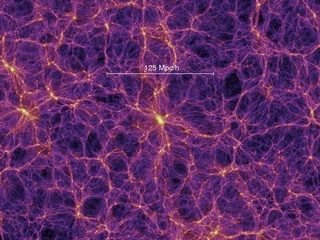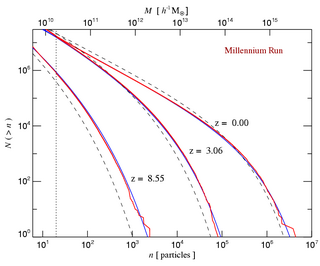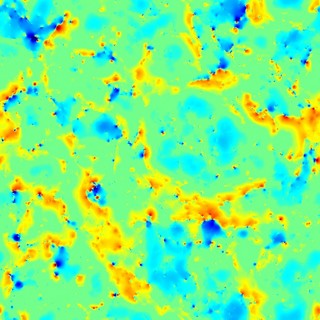|
|  |
Recent progress in observational cosmology has established a standard
model for the material content of the Universe, and its initial
conditions for structure formation 300000 years after the Big Bang.
Most of the mass in the Universe (~85%) consists of dark matter, an as
of yet unidentified weakly interacting elementary particle. Initial
fluctuations in this mass component, seeded by an early inflationary
epoch, are amplified by gravity as the universe expands, and
eventually collapse to form the galaxies we see today. To model this
highly non-linear and intrinsically three-dimensional process, the
matter fluid can be represented by a collisionless N-body system that
evolves under self-gravity. However, it is crucial to make the number
of particles used in the simulation as large as possible in order to
model the universe faithfully.
Scientists at the Max-Planck-Institute for Astrophysics,
together with collaborators in the international Virgo consortium,
were able to carry out a new simulation of this kind using an
unprecedentedly large particle number of more than 10 billion. This is
about an order of magnitude larger than the largest computations
carried out in the field thus far and significantly exceeds the
long-term growth rate of cosmological simulations, a fact that
inspired the name "Millennium Simulation" for the project. This
progress has been made possible by important algorithmic improvements
in the employed simulation code, and the high degree of
parallelization reached with it, allowing the computation to be done
efficiently on a 512 processor partition of the IBM p690 supercomputer
of the Computing Center of the Max-Planck Society (RZG). Still, the
computational challenge of the project proved to be formidable. Nearly
all of the aggregated physical memory of 1 TB available on the
massively parallel computer had to be used, and the analysis of the
~20 TB of data produced by the simulation required innovative
processing methods as well.
The simulation volume is a periodic box of 500 Mpc/h on a side, giving
the particles a mass of 8.6 x 108/h solar masses, enough to represent
dwarf galaxies by about a hundred particles, galaxies like the Milky
Way by about a thousand, and the richest clusters of galaxies with
several million. The top panel of Figure 1 gives a visual impression
of the dark matter structure on large scales at the present time. The
Millennium simulation shows a rich population of halos of all sizes,
which are linked with each other by dark matter filaments, forming a
structure which has become known as "Cosmic Web". The spatial
resolution of the simulation is 5 kpc/h, available everywhere in the
simulated volume. The resulting large dynamic range of 105 per
dimension in 3D allows extremely accurate statistical
characterizations of the dark matter structure of the universe,
including the resolution of dark matter substructures within
individual halos, as seen in the lower panel of Figure 1, where we
zoom in on one of the hundreds of rich galaxy clusters formed in the
simulation. In Figure 2, we show the non-linear halo mass function of
the simulation at different times, serving as an example for the
exquisite accuracy with which key cosmological quantities can be
measured from the simulation.
An important feature of the new simulation is that it gives an
essentially complete inventory of all luminous galaxies above about a
tenth of the characteristic galaxy luminosity. This aspect is
particularly important for constructing a new generation of
theoretical mock galaxy catalogues, which for the first time allow a
direct comparison with observational data sets on an "equal footing",
because the Millennium simulation has a good enough mass resolution to
yield a representative sample of galaxies despite covering a volume
comparable to the large observational redshift surveys that have
become available recently. The galaxy data obtained for the
Millennium simulation will be stored in a "theoretical virtual
observatory", allowing queries similar to those applied to large
observational databases. The large volume of the Millennium Simulation
is also crucial for studying rare objects of low space density, such
as rich clusters of galaxies, or the first luminous quasars at high
redshift. At the same time, the high dynamic range of the simulation
allows accurate theoretical predictions for effects of strong and weak
gravitational lensing, and it allows the study of fluctuations induced
in the cosmic microwave background by the time-varying gravitational
potential, as illustrated in the Figure 3. As cosmology enters a
"precision era", large computer simulations like the Millennium run
become ever more important to account for the full complexity of
cosmic structures, and to provide sensitive tests of our current
theoretical understanding.
Volker Springel
Further information:
 Virgo Consortium Virgo Consortium
 Virgo web page at the MPI for Astrophysik Virgo web page at the MPI for Astrophysik
A. Jenkins, C.S. Frenk, S.D.M. White, et al., "The mass function of dark
matter halos", Mon. Not. R. Astron. Soc., 321, 372 (2001)
V. Springel, N. Yoshida, S.D.M. White, "GADGET: a code for collisionless
and gasdynamical cosmological simulations", New Astronomy, 6, 79 (2001)
V. Springel, S.D.M. White, G. Tormen, G. Kauffmann, "Populating a cluster
of galaxies: Results at z=0", Mon. Not. R. Astron. Soc., 328, 726 (2001)
|



